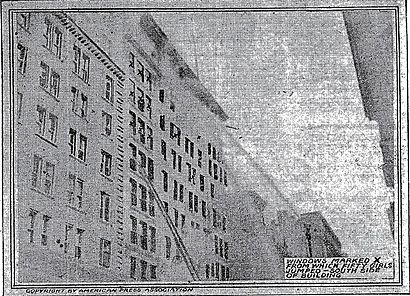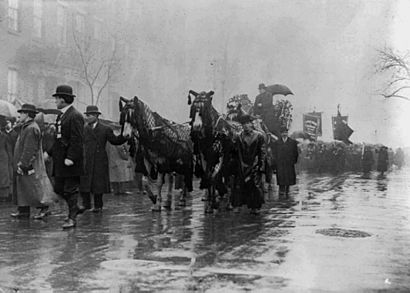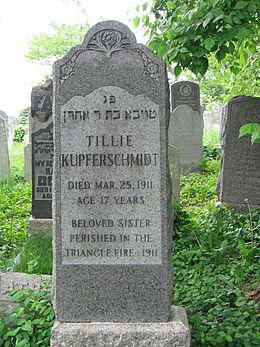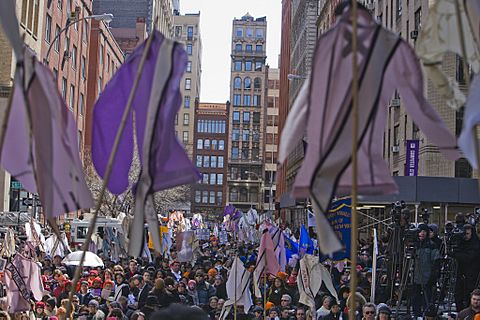Triangle Shirtwaist Factory fire facts for kids
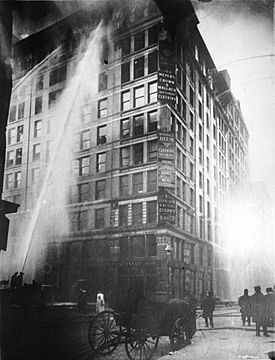 |
|
| Date | March 25, 1911 |
|---|---|
| Time | 4:40 p.m. (Eastern Time) |
| Location | Asch Building, Manhattan, New York City, New York, U.S. |
| Coordinates | 40°43′48″N 73°59′43″W / 40.73000°N 73.99528°W |
| Deaths | 146 |
| Non-fatal injuries | 78 |
The Triangle Shirtwaist Factory fire happened in New York City on Saturday, March 25, 1911. It was one of the worst industrial disasters in U.S. history. This terrible fire caused the deaths of 146 garment workers. Most of them were young women and girls. They died from the fire, breathing in smoke, or by falling or jumping from the building.
Most of the victims were young Italian or Jewish immigrant women and girls. Their ages ranged from 14 to 43. The factory was located on the 8th, 9th, and 10th floors of the Asch Building. This building, now called the "Brown Building", still stands today near Washington Square Park. It is an important historical landmark.
Many workers could not escape because the doors to the stairwells and exits were locked. This was a common practice then to stop workers from taking breaks or stealing. The fire led to new laws for better factory safety. It also helped the International Ladies' Garment Workers' Union (ILGWU) grow. This union fought for better working conditions for people in sweatshops.
Contents
About the Factory
The Triangle Waist Company made women's blouses called "shirtwaists". The factory was on the 8th, 9th, and 10th floors of the Asch Building. This building was in the Greenwich Village area of New York City. Max Blanck and Isaac Harris owned the factory.
About 500 workers were employed there. Most were young Italian and Jewish immigrant women and girls. They worked long hours, nine hours a day on weekdays and seven hours on Saturdays. For 52 hours of work, they earned between $7 and $12 a week. This was not much money, even back then.
The Fire Starts
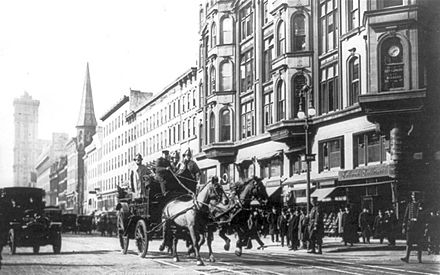
The fire started around 4:40 pm on Saturday, March 25, 1911. It began in a bin full of fabric scraps on the 8th floor. A person outside saw smoke and called the fire department at 4:45 pm. Both factory owners were there that day with their children.
Investigators believed the fire likely started from a match or cigarette thrown into the scrap bin. This bin held many pounds of fabric scraps. The scraps and hanging fabrics around the bin were very easy to burn. Smoking was not allowed in the factory, but some workers still smoked secretly.
The fire spread very quickly. A bookkeeper on the 8th floor called the 10th floor to warn them. But there was no alarm system, and no way to warn the workers on the 9th floor. A survivor named Yetta Lubitz said that on the 9th floor, the fire arrived at the same time as the warning.
Escape Attempts
The factory had several exits, like elevators, a fire escape, and stairways. But the flames blocked the Greene Street stairway. The door to the Washington Place stairway was locked. This was done to stop workers from stealing or taking unauthorized breaks. The foreman with the key to this door had already escaped.
Many workers tried to use the single fire escape outside. But it was flimsy and not well-built. It soon twisted and collapsed from the heat and too many people on it. About 20 victims fell nearly 100 feet (30 m) to their deaths.
The fire department arrived quickly. But their ladders were too short. They could only reach up to the 7th floor. This made it very hard to rescue people from the higher floors.
Elevator operators Joseph Zito and Gaspar Mortillaro were heroes. They went up to the 9th floor three times to save people. But eventually, their elevator rails bent from the heat. Some victims tried to escape by jumping into the empty elevator shaft. The impact of these bodies damaged the elevator car, making it impossible for more rescues. A reporter, William Gunn Shepard, described the terrible sound of bodies hitting the pavement.
Many people gathered on the street below. They watched in horror as 62 people jumped or fell from the burning building. A man named Louis Waldman, who later became a politician, described the scene. He said women were crying and fainting, and men were helpless.
After the Fire
In total, 146 people died in the fire: 123 women and girls, and 23 men. Most died from burns, smoke, or injuries from falling. The bodies were taken to Charities Pier for identification. Many victims were buried in different cemeteries. Six victims remained unidentified for a long time. A historian later identified them, and they were buried together under a special monument.
Changes and Legacy
The factory owners, Max Blanck and Isaac Harris, survived the fire. They were charged with manslaughter. Their trial began in December 1911. The jury found them not guilty of manslaughter. However, in a later civil lawsuit, they were found responsible for the deaths. The families of the victims received $75 for each person who died. The owners received much more money from their insurance company than they lost.
In 1913, Blanck was arrested again for locking a factory door during work hours. He was fined $20.
Rose Schneiderman, a union activist, spoke at a memorial meeting. She said that workers needed to organize to protect themselves. She believed that only a strong working-class movement could truly save them.
Others believed that new laws could help. A Committee on Public Safety was formed. It was led by Frances Perkins, who later became the U.S. Secretary of Labor. This committee worked to identify problems and push for new safety laws. They worked with politicians like Al Smith and Robert F. Wagner.
The New York State Legislature created the Factory Investigating Commission. This group looked into factory conditions. They interviewed many people and inspected factories. Their findings led to 38 new laws in New York state. These laws made New York a leader in worker safety reform. New laws required better building exits, fireproofing, fire extinguishers, alarm systems, and sprinklers. They also set limits on how many hours women and children could work.
The fire also led to the creation of the American Society of Safety Professionals in 1911.
The last living survivor of the fire was Rose Freedman. She died in 2001 at age 107. She was rescued from the roof of the building. Because of her experience, she supported unions her whole life.
In 2019, U.S. Senator Elizabeth Warren spoke near the factory site. She talked about the fire and its importance for workers' rights.
Remember the Triangle Fire Coalition
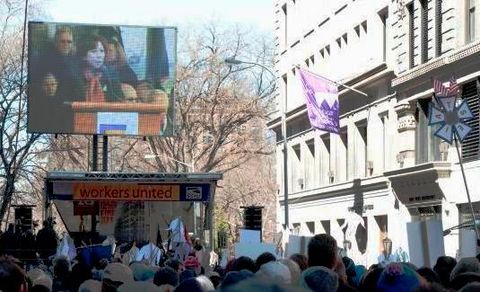
The Remember the Triangle Fire Coalition is a group of over 200 organizations and people. They formed in 2008 to remember the 100th anniversary of the fire. They also want to create a permanent public art memorial for the victims. This group includes unions, human rights groups, historical societies, and families of victims.
The Coalition grew from a public art project called "Chalk" by filmmaker Ruth Sergel. Every year since 2004, artists write the names, ages, and causes of death of victims in chalk outside their former homes.
100th Anniversary
Leading up to the 100th anniversary in 2011, the Coalition organized about 200 events. These included conferences, films, plays, art shows, and concerts. Many events took place in New York City and other cities across the U.S.
A ceremony was held in front of the building where the fire happened. Thousands of people marched through Greenwich Village beforehand. They carried shirtwaists with the names of those who died. Speakers included the U.S. Secretary of Labor, Hilda L. Solis, and New York City Mayor Michael R. Bloomberg. Many speakers called for stronger workers' rights.
At 4:45 pm EST, the exact time the first fire alarm sounded in 1911, hundreds of bells rang out across the nation. This was a way to remember the victims.
Permanent Memorial
The Coalition is working to create a permanent public art memorial at the fire site. The memorial will honor the victims and remind everyone about worker safety. It will also inspire future activists.
In 2012, the Coalition got permission to install a memorial on the Brown Building. They held a competition for the design. Richard Joon Yoo and Uri Wegman created the winning design. In 2015, New York Governor Andrew Cuomo announced $1.5 million in funds to build it.
The memorial design features a stainless-steel ribbon. It will flow down the corner of the Brown Building from the 9th floor. This marks where most victims died or jumped. The ribbon will have patterns from a cloth ribbon sewn by hundreds of volunteers. The names of all 146 workers who died will be cut into panels. These panels will let light shine through. At street level, a reflective stone glass panel will show the names and stories from survivors.
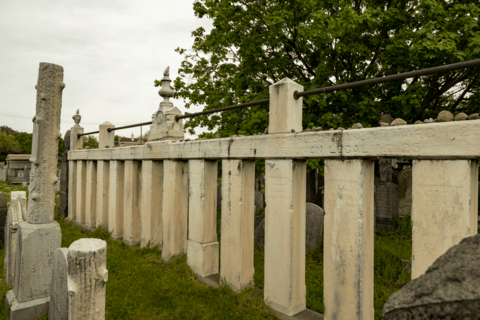
Mt. Zion Cemetery Memorial
There is another memorial at Mt. Zion Cemetery in Maspeth, Queens. It was put up by the Ladies Waist and Dress Makers Union Local No 25. It has stone columns and a large cross beam. Some of the writing on it is hard to read now.
In Popular Culture
The Triangle Shirtwaist Factory fire has been remembered in many ways.
Films and Television
- The Crime of Carelessness (1912): A short film inspired by the fire.
- With These Hands (1950): A film about the fire.
- The Triangle Factory Fire Scandal (1979): A TV movie about the event.
- American Pop (1981): An animated film with a scene about the fire.
- New York: A Documentary Film (1999): A PBS series that covered the fire in one episode.
- American Experience: Triangle Fire (2011): A documentary about the fire.
- Triangle: Remembering the Fire (2011): Premiered on HBO for the 100th anniversary.
- Warehouse 13 (2011): A TV show where characters find an artifact from the fire.
- Crazy Ex-Girlfriend: A TV show where characters bond over their shared interest in the fire.
Music
- "Dos lid fun nokh dem fayer" (1912): A Yiddish song about the fire.
- "My Little Shirtwaist Fire" (1996): A song by Rasputina.
- "The Triangle Fire" (2006): A song by The Brandos.
- Fire in my mouth (2018): A musical piece for 146 female voices and orchestra.
Theatre and Dance
- Slaughter City (1996): A play inspired by labor events, including the fire.
- Rags: A musical that includes the Triangle Shirtwaist fire in its story.
- One Hundred Forty-Six (2012): A modern dance concert about the fire.
- Triangle (2015): A stage musical set on the 100th anniversary of the tragedy.
Literature
- Triangle: The Fire That Changed America (2003) by David Von Drehle: A non-fiction book.
- The Triangle Fire (1963) by Leon Stein: Another non-fiction book.
- Fragments from the Fire (1987) by Chris Llewellyn: A book of poetry.
- Triangle (2006) by Katharine Weber: A novel about the last living survivor.
- Uprising (2007) by Margaret Peterson Haddix: A historical novel for young adults.
- Threads and Flames by Esther Friesner: A novel about a girl working at the factory.
- Ashes of Roses (2004) by Mary Jane Auch: A historical novel for young adults.
- The Goon issue No. 37: A comic book with a similar fire story.
- "Heaven Is Full of Windows" (2009) by Steve Stern: A short story.
- "Mayn Rue Platz" (My Resting Place): A poem by former Triangle employee Morris Rosenfeld, set to music.
- Afterlife (2013) by Stephen King: A short story about the fire.
- New York by Edward Rutherfurd: A novel where a character dies in the fire.
- East River (1946) by Sholem Asch: A novel telling the story through an Irish girl's eyes.
- The Hidden Palace (2021) by Helene Wecker: A historical fantasy novel where the fire affects characters.
Images for kids
See also
 In Spanish: Incendio en la fábrica Triangle Shirtwaist de Nueva York para niños
In Spanish: Incendio en la fábrica Triangle Shirtwaist de Nueva York para niños


